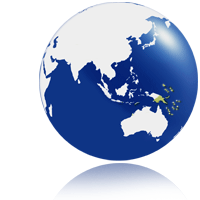Global Connectivity: World Regions
|
|
Americas
|
Africa & the Middle East
|
Asia & Pacific
|
Pacific Islands
The Pacific Islands Region is made up of countries with very diverse economies, populations and geographic spread. Population levels range from under 20,000 to over 7 million, and whilst some countries consist of a single island, others are spread over many geographically dispersed islands. Overall, the region covers a surface area three times the size of Europe and includes the Cook Islands, the Federated States of Micronesia, Fiji, Kiribati, the Marshall Islands, Nauru, Niue, Palau, Papua New Guinea, Samoa, the Solomon Islands, Timor-Leste, Tonga, Tuvalu and Vanuatu.
Today, connectivity within the region and to the global research and education networking community is very limited. Satellite links enable campuses of the University of the South Pacific to interconnect, with a link to AARNet in Australia providing international connectivity. In addition, RENATER, the French NREN, has low-capacity links to New Caledonia, Wallis and Fortuna, and French Polynesia.
ACP Connect Study for the Pacific Region
In 2012 a study was carried out to identify the research network landscape in the ACP Pacific Region, evaluate the possible need for a regional research and education network and propose a viable roadmap for its implementation.
The ACP Connect Study for the Pacific Region included a survey of the Pacific context regarding research and education networking, including the status of every ACP country, the relevant studies available, the regulatory environment and the expectations for R&E, and identified potential user institutions both at the regional and national levels.
The Final Report of the ACP Connect Study for the Pacific Region, published in November 2012, is available to download here.
ACP Connect Conference for the Pacific Region
In April 2013, the ACP Connect Conference in the Pacific Region was held in Apia, Samoa. Organised in the context of the ACP Connect Study, the conference brought together representatives from the target countries in the region and external organisations including the ACP Secretariat, DEVCO of the European Commission, DANTE in Europe and the NRENs of Australia and New Zealand.
One of the aims of the event was to increase awareness of the added value of NRENs and potential RENs among decision-makers in the Pacific region, with a focus on the deployment of a regional network in the region and its interconnection with GÉANT. The conference provided an opportunity to take stock of the current achievements in the establishment of the NRENs, and of the associated Research Networks and International Programmes in the Pacific.
The conclusions reached by the conference delegates were as follows:
- National and Regional REN should provide the connectivity support in promoting the Research culture and in facilitating Education development;
- A regional initiative is the best approach to solve connectivity issues in terms of capacity building, global broadband solutions, monopolistic position of providers;
- Some of the very small Pacific Island Countries (PICs) would not develop a national organisation, but base themselves on the regional organisation;
- For some islands and due to their very low population size there is no case for a stand-alone R&E initiative, but that any initiative would need to solve the requirements of the R&E community included the primary and secondary schools;
- There is a need to initially focus on the improved access to educational teaching and learning resources;
- The next steps need to be built on existing organisational structures or closely explore synergies;
- The Pacific Island Country (PIC) delegations will have to work on their governments raising awareness of benefits of the connectivity opportunities for R&E development and the possibilities of getting funding bodies involved in the financing of these systems on behalf of the PIC governments;
- The participants are aware that the EC and the other partners can be approached to facilitate the development of national and regional REN initiatives.




